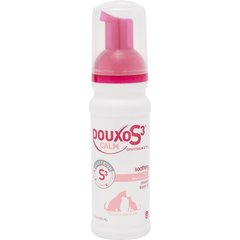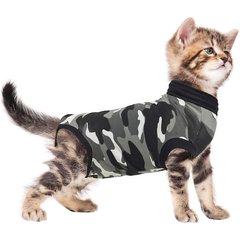Cornish Rex
It’s easy to see why the Cornish Rex turns heads: The breed’s short and curly or wavy coats, angular faces, high cheekbones, and large ears stand out from other cats. Their athletic build and kitten-like energy also earn them the nickname "Greyhound of the cat world," says Mark Kantrowitz, a champion cat fancier of Cornish Rex cats.
These curly-haired cuties can grow to be 6–10 pounds and 8–12 inches at the shoulders.
Caring for a Cornish Rex
Most cats have three layers of fur to keep them warm: A thick outer layer of guard hairs, a middle layer of awn hairs, and a soft and fine inner layer of down, says Lisa Kuta, co-founder of Cornish Rex Friends, a national Cornish Rex rescue. But not Cornish Rexes. Due to a genetic mutation, they only have the down layer, giving them the feel of cashmere and rows of curls called a marcel wave.
But don't be fooled by the Cornish Rex's low-shedding coat—they aren't completely hypoallergenic cats. The protein that triggers allergies in humans is found in their skin, fur, and saliva, so no cat is truly allergy-free. But the good news is that because the Cornish Rex has less fur than other breeds, they may be a better choice for those with mild to moderate cat allergies.
If you’re interested in bringing home a rex cat, keep in mind that each feline in the Rex cat breed family, which includes the Cornish Rex, Devon Rex, and Selkirk Rex, is unrelated. While they all have a curly coat trait, each is a different breed that developed independently from spontaneous mutations.
Shop for Your Breed
- Douxo S3 CALM Soothing Itchy, Hydrated Skin Dog & Cat Mousse, 5.1-fl oz bottle$28.82Chewy Price
- Litter-Robot 4 with Step & Core Accessories Kit Cat Litter Box, Black$799.99Chewy Price
- Purina Pro Plan Veterinary Diets Crunchy Bites Crunchy Cat Treats, 1.8-oz bag$6.99Chewy Price
- Suitical Recovery Suit for Cats, Black Camo, X-Small$30.95Chewy Price
Cornish Rex Health Issues
Cornish Rex cats are generally healthy with a lifespan of 11–15 years, but the breed does have a few common health concerns. Pet parents might want to consider purchasing cat insurance before bringing home a Cornish Rex kitten.
Progressive Retinal Atrophy (PRA)
Progressive retinal atrophy is a genetic vision condition that affects a few cat breeds, including the Cornish Rex. The condition causes deterioration of the retina, leading to blindness. Unfortunately, there is no cure for PRA. However, cats without vision can live a full and happy life with some extra help around the house.
Night blindness is typically the first sign of PRA and can appear in young cats around 3–5 years of age. Symptoms gradually worsen over time, ultimately leading to complete blindness.
To reduce the prevalence of PRA, reputable breeders test their cats for genetic markers of the condition. Carriers of PRA shouldn’t be bred.
Hypertrophic Cardiomyopathy
Hypertrophic cardiomyopathy (HCM) is a common heart disease in cats that causes the walls of the heart to thicken; this can make it difficult for the heart to pump blood effectively. Typically an inherited condition, HCM is less commonly caused by high blood pressure, cancer, or a hormonal imbalance.
The condition often goes undetected in its early stages because many cats have no noticeable symptoms. However, as the disease progresses, cats may experience:
-
Weight loss
-
Difficulty breathing
-
Pale gums
Early detection and management of HCM are important for improving an affected cat’s lifespan.
What To Feed a Cornish Rex
Cornish Rex cats should be fed commercial cat food that meets the nutritional recommendations set by the Association of American Feed Control Officials (AAFCO) for their life stage (kitten, adult, or senior). Because cats are obligate carnivores, they must eat food containing animal products in the form of meals, by-products, or whole meat ingredients.
How To Feed a Cornish Rex
Instead of leaving food out all day, consider feeding your cat multiple smaller meals throughout the day. This approach helps prevent overeating and creates a routine, which cats tend to appreciate.
“Cornish Rex cats are very intelligent and dexterous,” Kuta says. Their cleverness often leads to mischievous antics, like opening cabinets and drawers (so be sure to cat-proof your home!). It also lends to Corish Rex's exceptional skills in solving food puzzles, which tap into their natural foraging and hunting instincts and keep boredom at bay.
How Much Should You Feed a Cornish Rex?
While the bag or can of cat food will provide recommendations on how much to feed your Cornish Rex based on their body weight, the best way to determine your cat’s daily caloric needs (and therefore portion sizes) is to ask your veterinarian. They’ll base your cat’s nutritional needs on their age, current weight and ideal weight, activity level, and overall health.
Behavior and Training Tips for Cornish Rexes
Cornish Rex Personality and Temperament
As lively, social felines, many Cornish Rex cats do well in bustling, multi-pet households. “Most Cornish are curious about strangers and love meeting new people,” Kuta says. “They run to the door when they hear the bell or footsteps, excited to see who is there.”
Not often described as independent companions, Kuta says if a Cornish Rex isn't busy playing, they’re usually on top of or next to their people.
Kantrowitz can attest to this. “One of my cats likes to stand up on her hind legs so that she can head-bump my hand,” he says. “The other likes to assume the cat-loaf position on one of my legs.” Partially due to their lack of fur, Cornish Rexes are big cuddlers, often seeking the warmth of a human lap or cozying up under the covers.
Cornish Rex Behavior
Cornish Rex cats are a bundle of energy, more so than the Devon Rex, Kuta says. Their powerful legs give them impressive jumping abilities, making them masters of scaling furniture and reaching high places. Providing tall cat trees, shelving, and perches shouldn’t be overlooked when bringing a Cornish Rex home. And don't forget to cat-proof drawers and cupboards to keep those curious paws at bay.
While known to entertain themselves with independent playtime, Cornish Rex cats cherish interactive play sessions with their human companions. Aim for one to two play sessions a day, Kuta says. “Part of the fun of having a Cornish Rex is coming up with new games to play with them in addition to such classics as fetch and jump for the wand toy,” she says.
Cornish Rex Cat Training
Highly intelligent cats with a knack for independent problem-solving, Cornish Rex cats revel in mastering new tricks. Their dexterity, coupled with strong emotional bonds with their human companions, makes them good candidates for positive reinforcement training.
Fun Activities for Cornish Rex Cats
-
Solving puzzle feeders
-
Foraging for treats around the house and in snuffle mats
-
Playing with interactive toys
-
Bird watching from a window
-
Lounging in a sunny spot
-
Climbing to a high perch
-
Cuddling with their humans or other pets
-
Being around people and other pets
Cornish Rex Grooming Guide
Cornish Rex cats also can be a great fit for those who enjoy spending quality time with their furry friend through regular grooming sessions.
Skin and Coat Care
Regular grooming is needed to keep their skin and fur healthy. Kuta recommends bathing Cornish Rex cats with very thin coats once a week to every two weeks, as they tend to accumulate oils and can appear greasy. However, Kantrowitz says his Cornish Rex cats don't easily accumulate oils and only require bathing just before a show.
Due to a genetic mutation, Cornish Rex cats only have the down layer of fur, giving them the feel of cashmere and rows of curls called a marcel wave.
No matter how often you choose to bathe your Rex kitten or cat, always opt for a cat-safe shampoo. Starting a bathing routine when your cat is still a kitten will make the process less stressful and more enjoyable for both of you.
Eye Care
Cornish Rex cats may accumulate more dirt, debris, and oils around their eyes than otter cat breeds because they have less fur. If you notice these substances around your cat’s eyes, gently wipe their eyes clean with a soft, damp cloth. If you notice abnormal discharge or redness of the eye, your cat may have an eye infection, which your veterinarian can treat.
Ear Care
Cats with less fur, such as Rex cats, may require weekly ear cleaning. If you're unsure how to clean your cat's ears, ask your veterinarian for a demonstration.
After baths, thoroughly dry your cat's ears to prevent infections. Signs of ear infections in cats include abnormal discharge, signs of discomfort such as scratching the head or ears, shaking of the head, a foul smell, and redness.
Considerations for Pet Parents
Cornish Rex cats are generally high-energy, playful cats that require plenty of opportunities to exercise. They’re also social and often the first to greet strangers at the door; likewise, they eagerly seek out warm laps or amicable furry friends to cuddle with.
“When adding a Cornish Rex to your family, talk extensively with the breeder or rescue about your lifestyle to ensure the specific Cornish is a match for you,” Kuta says. “Some Cornish thrive as only pets with a sole person, others need active households with multiple people and pets.”
Cornish Rex FAQs
What’s the difference between a Cornish Rex and a Devon Rex cat?
Originating in Cornwall, England, the Cornish Rex is a slender cat with large ears and an egg-shaped head. Their counterpart, the Devon Rex, originated in Devon, England, and are known for their pixie-like and “bottom-heavy” appearance, Kuta says.
Both Cornish Rex and Devon Rex cats sport curly coats with distinct textures. Cornish Rex cats have a single layer of thin, wavy fur, while Devon Rex cats have two layers of fur. "Cornish are generally a little more active than Devons, especially as they age," Kuta says, and Cornish Rex cats are more socially engaged than their Devon counterparts.
How much does a Cornish Rex cost?
The price of a Cornish Rex can be between $800 and $1500. But rescues, such as the Cornish Rex Friends, offer these lovable felines for a more affordable adoption fee. Depending on the cat's age and any special needs, you can expect to pay between $100 and $300 to adopt a Cornish Rex, Kuta says.
Are Cornish Rex cats cuddly?
Cornish Rex cats are known for being very cuddly, in part due to their lack of fur. “They like sources of heat, such as radiators and people's laps,” Kantrowitz says.
What’s special about a Cornish Rex cat?
Cornish Rex cats are special for their unique curly coat, their playful personalities, and their loving nature. They are also very intelligent and can be trained to do tricks.
Featured Image: Adobe/Rita Kochmarjova




